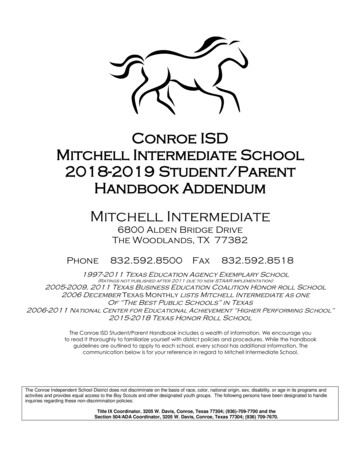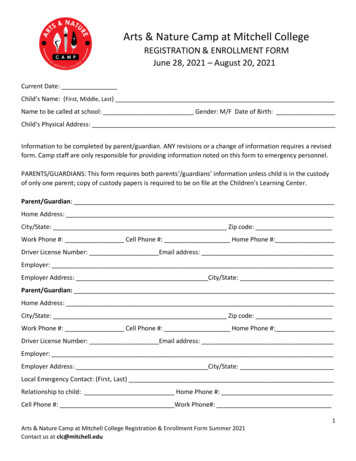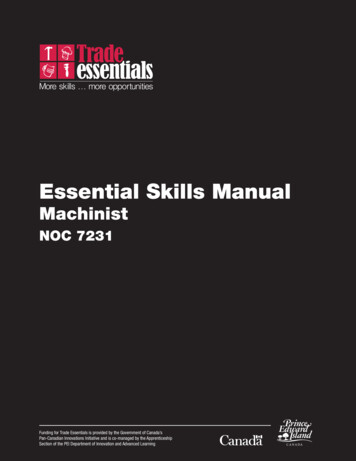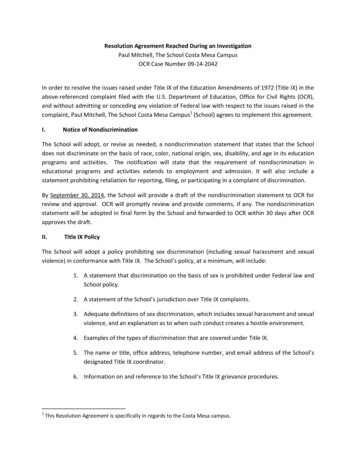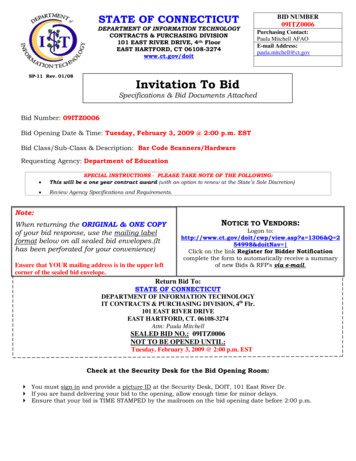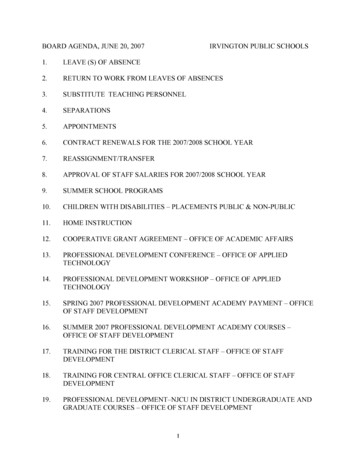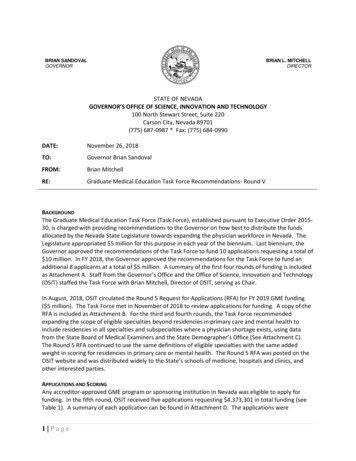
Transcription
BRIAN SANDOVALGOVERNORBRIAN L. MITCHELLDIRECTORSTATE OF NEVADAGOVERNOR’S OFFICE OF SCIENCE, INNOVATION AND TECHNOLOGY100 North Stewart Street, Suite 220Carson City, Nevada 89701(775) 687-0987 * Fax: (775) 684-0990DATE:November 26, 2018TO:Governor Brian SandovalFROM:Brian MitchellRE:Graduate Medical Education Task Force Recommendations- Round VBACKGROUNDThe Graduate Medical Education Task Force (Task Force), established pursuant to Executive Order 201530, is charged with providing recommendations to the Governor on how best to distribute the fundsallocated by the Nevada State Legislature towards expanding the physician workforce in Nevada. TheLegislature appropriated 5 million for this purpose in each year of the biennium. Last biennium, theGovernor approved the recommendations of the Task Force to fund 10 applications requesting a total of 10 million. In FY 2018, the Governor approved the recommendations for the Task Force to fund anadditional 8 applicants at a total of 5 million. A summary of the first four rounds of funding is includedas Attachment A. Staff from the Governor’s Office and the Office of Science, Innovation and Technology(OSIT) staffed the Task Force with Brian Mitchell, Director of OSIT, serving as Chair.In August, 2018, OSIT circulated the Round 5 Request for Applications (RFA) for FY 2019 GME funding( 5 million). The Task Force met in November of 2018 to review applications for funding. A copy of theRFA is included as Attachment B. For the third and fourth rounds, the Task Force recommendedexpanding the scope of eligible specialties beyond residencies in primary care and mental health toinclude residencies in all specialties and subspecialties where a physician shortage exists, using datafrom the State Board of Medical Examiners and the State Demographer’s Office (See Attachment C).The Round 5 RFA continued to use the same definitions of eligible specialties with the same addedweight in scoring for residencies in primary care or mental health. The Round 5 RFA was posted on theOSIT website and was distributed widely to the State’s schools of medicine, hospitals and clinics, andother interested parties.APPLICATIONS AND SCORINGAny accreditor-approved GME program or sponsoring institution in Nevada was eligible to apply forfunding. In the fifth round, OSIT received five applications requesting 4,373,301 in total funding (seeTable 1). A summary of each application can be found in Attachment D. The applications were1 Page
distributed to the members of the Task Force who individually scored the applications. Table 2 containsthe average scores for each application. Task Force members reconvened on March 7, 2018, to discussthe applications and make recommendations.TABLE 1ApplicantSouthern NevadaHealth DistrictUNLV School ofMedicineUNLV School ofMedicineUNLV School ofMedicineValley HealthSystemProgram NameTypeLocationPublic Health and GeneralPreventive MedicineCritical Care FellowshipAddendumCritical Care SurgeryFellowshipGeriatrics FellowshipNewClarkRequestedAmount 1,048,781.00NewClark 80,000.00ExpansionClark 1,560,179.00NewClark 722,346.00Infrastructure DevelopHenderson HospitalNewClark 961,995.00TABLE 2ApplicantSouthern Nevada Health DistrictUNLV School of Medicine (Critical Care Addendum)UNLV School of Medicine (Critical Care Surgery)UNLV School of Medicine (Geriatrics)Valley Health SystemAverage Score(105 possible)64.7893.6390.1377.1383.43The Task Force discussed each application in order beginning with the highest scoring application. Eachapplicant was present and responded to questions from Task Force members. Below is a brief summaryof the discussion for each applicant.UNLV CRITICAL CARE ADDENDUM- The original application approved and funded in Round 4contained an error in the budget table that only funded two of the three residents. UNLVsubmitted a revised budget and requested the additional 80,000. The Task Force questioned ifUMC’s Board of Trustees had approved funds to sustain the program and UNLV informed themembers that the vote would not have occurred regardless until the conclusion of the programin 2020.UNLV CRITICAL CARE SURGERY- The Task Force questioned the salary levels in the budget andwas informed that the salaries were comparable to similar programs in the Western UnitedStates. No significant concerns were raised.VALLEY HEALTH- VHS representatives explained that the new Henderson Hospital was notdesigned for GME and the funding would provide space and equipment that would be used bymany residents in the coming years. Although the proposal would not add new residents, it2 of 4
would expand the opportunities, experiences, and exposure for the residents. VHS indicatedthat the construction of the new GME space would be completed by July, 2019 and would beready for residents starting that month. At any given time, 30 residents at a time might belocated at the hospital but residents would rotate through all of the VHS hospitals during theirresidencies.UNLV GERIATRICS- The Task Force had some concerns regarding the sustainability andaccreditation of the program, given that UNLV planned to fund 40% of the ongoing coststhrough philanthropic donations. UNLV indicated they want to include community resources inthe sustainability of the program and would have other program resources if philanthropy cameup short. The representative from the VA on the Task Force committed to funding one of theslots in the future. The Task Force also had questions regarding the recruitment of fellows,given that geriatrics programs around the country have had unfilled slots. UNLV responded thatit expects there will be a strong internal pipeline for the program and that Las Vegas will be apopular destination for training.SOUTHERN NEVADA HEALTH DISTRICT (SNHD)- The Task Force had concerns with SNHD’s lack ofaccreditation. SNHD informed the Task Force that it was in the process of seeking accreditationand was confident that ACGME would accredit the program in April, 2019. The Task Forceinquired whether an April accreditation would allow the program to start in July, 2019 and SNHDindicated that the timeframe would work. There were also concerns about the sustainability ofthe program given its expected ongoing costs and lack of an internal revenue source. SNHDindicated that a combination of applying for federal grants, legislation increasing property taxrates, and increases to its general fund from the County would cover the ongoing costs of theprogram. There were concerns that the two-year program only offered two months of directpatient care. However, SNHD said the program’s emphasis on population-based health wasdifferent than other individual-care programs and that it followed the format of other, similarprograms. There was discussion about whether a Master of Public Health (MPH) degree fromUNLV was required and whether grant funds should pay for the tuition costs. SNHD indicatedthe MPH was required and was standard for this type of fellowship. SNHD also indicated theywere looking to establish formal relationships with hospitals and thought student interest in theprogram would be high.TASK FORCE RECOMMENDATIONSAt the conclusion of the question and answer period with applicants, the Task Force began allocatingavailable funding to the applications. The Task Force unanimously voted to fully fund four of theapplications- the three applications from UNLV and the application from Valley Health. The Task Forcewas split on whether to fund SNHD’s application with four members voting in favor, four against, andone member abstaining. Table 3 below contains the Task Force’s award recommendations.3 of 4
TABLE 3ApplicantSouthern Nevada Health DistrictUNLV School of Medicine (Critical CareAddendum)UNLV School of Medicine (Critical Care Surgery)UNLV School of Medicine (Geriatrics)Valley Health System (Henderson)TotalAverage 7.1383.43 1,560,179.00 722,346.00 961,995.00 4,373,301.002290297AwardedAmount 1,048,781.00 1,048,781.001 80,000.00 80,000.00 1,560,179.00 722,346.00 961,995.00 4,373,301.00NEXT STEPSOnce final funding decisions have been made by the Governor, OSIT staff will draft award agreementsand advance the funding. Grantees will have two years from the award date to spend the funds.After the Governor’s funding decisions, at minimum, 626,699 will be available from this fiscal year’stotal allocation of 5,000,000. The Task Force agreed on a timeframe to do another round of fundingwith a new RFA to be released in January and applications due in late April. The Task Force willreconvene in May to make review the applications and make recommendations to the Governor.The Task Force concluded the meeting with a discussion regarding the data needed by the State to mosteffectively grow the physician workforce. The Task Force endorsed the recommendation of soliciting viaRFA applications to fund research that would inform the Governor, Legislature, and the Task Force onthe limitations of existing data, GME data needs, including return on investment and retention, and theoutcomes of the previous GME funding. The Task Force also agreed that GME funds in future bienniashould offer more tools to programs to recruit and retain physicians in the state, including loanforgiveness and relocation programs.1The Task Force was not unanimous in its recommendation. See summary of recommendations above foradditional details.2VHS’ application will not add any new slots; rather, it will add an additional location where the 90 residents inVHS’ program will do their residencies. See VHS summary above for additional details.4 of 4
ApplicantUNLV School of MedValley HealthUNR School of MedUNLV School of MedUNR School of MedUNR School of MedValley HealthMountain ViewTouro UniversityUNR School of MedValley HealthMountain ViewSNHDUNLV School of MedUNLV School of MedUNR School of MedSouthern Hills HospitalValley HeathAttachment A: GME Funded ApplicationsProgram NameTypePsychiatry Residency ProgramExpansionInfrastructure Development- 4 programsNewAdult and Child PsychiatryNewOBGYNNewInternal MedicineExpansionGeriatric MedicineExpansionInfrastructure Development- 4 programsNewOBGYNNewGeriatric Medicine FellowshipNewFamily & Community MedicineExpansionSurgeryNewPhysical Medicine and RehabilitationNewPreventive Medicine ResidencyNewCritical Care FellowshipNewPediatric Emergency Medicine FellowshipNewFamily Medicine TrainingExpansionPsychiatry ResidencyNewFamily Medicine ResidencyExpansionTotal Funding AwardedLocationAwarded AmtClark 900,000Clark 600,000Washoe/Rural 500,000Clark 1,300,000Washoe 1,700,000Washoe 500,000Clark 1,050,000Clark 850,000Clark 1,200,000Washoe/Rural 1,400,000Clark 794,410Clark 888,000Clark 315,161Clark 454,817Clark 922,433Rural 251,969Clark 1,054,000Clark 319,210 15,000,000
Attachment B: Request for ApplicationsGraduate Medical Education New and Expanded ProgramGrants Round VIMPORTANT INFORMATIONPurpose:To increase and fill the number of accreditor-approved residency positions in existingprograms, and/or establish new graduate medical education (GME) programs withpositions.Proposals Due:October 30, 2018 at 5:00 p.m. PTFunding Available: 5,000,000Cost Sharing/Match:NoneBidder’s Call:September 25, 2018 at 11:00 a.m.Dial in info:775-687-0999Access code: 70987#Applicant Q&AThere will be an optional opportunity for applicants to be present to answer questionsfrom the review committee made up of members of the GME Task Force. The date, timeand locations in Carson City and Las Vegas for the question and answer session will beposted on or before October 30, 2018 at http://osit.nv.gov.Final Funding Decisions:On or before November 30, 2018.Eligibility:An eligible applicant is an accreditor-approved GME program or a sponsoring institutionthat has an eligible program or intends to create an eligible program within the grantterm.Website:http://osit.nv.gov. Please check the website regularly for updates.Contact:Brian MitchellDirector, Governor’s Office of Science, Innovation and Technologyblmitchell@gov.nv.gov775-687-0987
REQUEST FOR APPLICATIONSGRADUATE MEDICAL EDUCATION NEW AND EXPANDED PROGRAM GRANTSINTRODUCTION:Nevada consistently ranks among the most underserved states in most areas of healthcare delivery, both in urban andrural settings due in large part to shortages of physicians.On March 11, 2014, Governor Brian Sandoval issued Executive Order 2014-07 which created a Task Force on GraduateMedical Education (GME) and directed it to make recommendations in a report to the Governor on how to increase thegraduate medical workforce in Nevada. The Task Force recommended that the Governor fund additional residency slotsand that funding be available to both public and private institutions to either expand or create new GME programs.As a result of the Task Force’s recommendations, the Governor requested and the Legislature appropriated the sum of 10 million ( 5 million in FY2018 and 5 million in FY2019) for the purpose of GME. The primary focus of the additionalslots is to be for primary care and mental health. On November 13, 2015, the Governor issued Executive Order 2015-30,reestablishing the GME Task Force to act as an advisory body and provide recommendations to the Governor on how bestto distribute the GME funds allocated by the Legislature, and directed the Governor’s Office of Science, Innovation andTechnology (OSIT) to manage the grant. The Task Force will review and score responses to this Request for Applicationsto inform its recommendations to the Governor. The Governor will make final funding decisions.SECTION I: DESIRED OUTCOMESPurpose:The State, through Graduate Medical Education New and Expanded Program Grants (hereafter GME Grants), seeks tomeet its growing healthcare needs and grow its physician workforce by increasing support for training. Given limitedresources, the State has chosen to focus this application on increasing the number of physicians with primary care and/ormental health training. Primary care and mental health training are defined in Section II, under the eligible uses of fundingsection. However, applications may be made for GME programs in any specialty or subspecialty that meets eligibilitycriteria outlined below.SECTION II: AWARD INFORMATIONAwardsThe State intends to distribute several rounds of grants over this biennium. The State will distribute up to 5 million ineach fiscal year. This Request for Applications represents the fifth round since the inception of the grant program. TheState reserves the right to determine the number of applications awarded based on funds available and projects selected,and may issue subsequent Requests for Applications. Applications should be crafted without expectation of futurefunding. In order to receive funding, applicants must completely follow application instructions, including formatting, andprovide all required information. More information on the award decision process may be found in Section V.Submission Timeline and InstructionsSubmit one (1) electronic copy of the application in a single pdf by 5:00 p.m., October 30, 2018 to:Brian MitchellGovernor’s Office of Science, Innovation and Technologyblmitchell@gov.nv.govApplications must be received by the date above. Applications received after the date above will not be considered.
Eligible Uses of FundingThe State will provide initial startup funding to eligible institutions for costs not already incurred that are associated withstarting new programs or expanding existing GME residency or fellowship programs. Programs must provide training infields or specialties where the number of licensed physicians per 100,000 population in the region where the GME programis located falls below the U.S. average. Added weight in scoring, described below in Attachment A, will be given toprograms that provide training in primary care and/or mental health. Primary care is defined as: family medicine, internalmedicine, pediatrics, internal medicine/pediatrics, geriatrics, and OB/GYN. Mental health care is defined as: psych andpsych fellowships. Please see Attachment B for the list of licensed physicians per 100,000 in Nevada by specialty, brokendown by region, compared to the national average. For ease of reference, specialties in counties with green numbers areabove the national average and are not eligible for funding.The focus of this funding is on training in specialties where the number of licensed physicians in the region is below theU.S. average. Applications for programs that provide training in subspecialties or fellowships are welcome, provided theapplicable rate of licensed physicians in the region also falls below the U.S average, and will need to provide a very strongarticulation of need, backed by local data.Examples of startup costs include: costs associated with hiring faculty or administrative support; facilities costs associated with education such as classrooms and associated IT; salaries, benefits, and professional liability insurance for participating residents of residents and fellows. Fundingrequested for salaries, benefits, and insurance will require special justification in terms of impact, return oninvestment, and sustainability.Ineligible Uses of FundingGrant funds may not be used for: research or feasibility studies including travel for the purpose of research; the training of undergraduate medical students; compensation for residents subsidized by any other funding sources; compensation which is higher than the normal rate for a similar position at the institution; construction costs not directly related to education, such as facilities that are strictly clinical in nature or parking; equipment costs not directly related to education; salary expenses, such as bonuses, beyond base salaries and standard benefits; no indirect cost allocation is allowable under this grant; and any costs associated with applying for, administering, or complying with the requirements of this grant.Cost SharingNo cost sharing or matching is required.Grant PeriodThe grant reporting period is 10 years from the grant award date. The Legislature appropriated 5,000,000 in FY2018 and 5,000,000 in FY2019. FY2019 funding must be obligated by June 30, 2019. More information on the award process iscontained in Section V. Awardees are required to submit quarterly reports to OSIT until all grant funding has been spentand annual reports thereafter until the conclusion of the grant period. More information on the reporting process can befound in Section V.SECTION III: ELIGIBILITY INFORMATIONEligible ApplicantsAn eligible applicant is an accreditor-approved GME program or a sponsoring institution located in Nevada that has aneligible program or intends to create an eligible program within the grant term. Institutions may be public or private,
allopathic or osteopathic. Awards may be granted to individual institutions, including universities, hospitals, communityhealth centers or other healthcare entities, or to consortia where two or more institutions share resources includingfacilities, administration, faculty and costs. Institutions may submit more than one application.SECTION IV: APPLICATION AND SUBMISSION INFORMATIONA comprehensive, well-written application provides all the information necessary for a complete evaluation. The reviewcommittee will use the rubric located in Attachment A to evaluate applications. A complete application will include thefollowing five (5) components listed below and described later in greater detail. Each section inside the grant shouldinclude headings and subheadings.1) Cover Sheet2) Project Abstract;3) Project Narrative;4) Budget Plan;5) Letters of Commitment.Incomplete applications or applications that do not follow the submission requirements, including the formattingrequirements described in detail below, as of the filing deadline, will be disqualified and will not be scored.1. Cover Sheet (Pass/Fail)Format: The cover sheet must not exceed one (1) page, is not included in the 20-page narrative limitation and must containthe following information: Applicant InformationOrganization name, full mailing and physical addresses, phone number, fax number, federal tax IDnumber, DUNS number, and website (if applicable)Project InformationTitle, county location, type of award requested (expanded or new), program specialty and length, originalaccreditation date (existing programs) or accreditation application date and expected start date (newprograms), and proposed dollar amountProject Director Information (overall project responsibility)Full name, title, mailing and physical address, day-time & evening phone, email addressProject Contact (daily project contact – if different than director)Full name, title, mailing and physical address, day-time & evening phone, email addressSignatureThe Cover Sheet must be signed by an individual who is legally authorized to submit the application onbehalf of the applicant. Include printed name and title.2. Project AbstractFormat: The Project Abstract must not exceed one (1) page, it must be double-spaced, Times New Roman 12-point fontwith 1-inch margins on all sides of 8½ by 11 size (letter size) paper.The project abstract must succinctly summarize the proposed project and should include:1.2.3.4.A brief summary of the project;Specific, measurable objectives and/or goals;Collaboration and partnerships; andExpected results and/or outcomes.
3. Budget Narrative and Plan (15 points possible)Format: The budget narrative must not exceed one (1) page, it must be double-spaced, Times New Roman 12-pointfont with 1-inch margins on all sides of 8½ by 11 size (letter size) paper. There is no page limit on the budget plan(table).Applicant is required to submit a 1) budget narrative and a 2) budget plan.1) The budget narrative must demonstrate a clear and strong relationship between the program’s expenses andthe program’s goals and activities. The budget narrative should be detailed, reasonable and adequate, costefficient, and should align with the proposed work plan. From the budget narrative, the reviewer should beable to assess how the budget expenditures relate directly to the goals of the program. The budget narrativedoes not count towards the page limit of the Project Narrative.2) The budget plan should be completed in a table. Please be specific and include as much line-item detail as isreasonably possible. Use this space to provide more specific justification for expenditures mentioned in theBudget Narrative. Break down cost categories such as “Faculty,” “Facilities,” “Salaries,” and “Insurance” toindividual components so that it is clearly understood how funding will be spent. For example, for travel, listcosts for flights, hotel, per diem, and transportation. All program expenses should be accounted for.4. Project NarrativeFormat: The Project Narrative must not exceed twenty (20) pages, it must be double-spaced, Times New Roman 12-pointfont with 1-inch margins on all sides of 8½ by 11 size (letter size) paper. Tables, graphs, charts, and other visuals may beused and do not have to be double-spaced. The entire narrative, including attachments, tables, graphs, and charts mustconform to the twenty (20) page limit.The following information must be contained within the Project Narrative:A. Needs Assessment (25 points possible)1) Provide a clear and concise overview of the need for the proposed training program, including gaps in thecurrent workforce, illustrated with local labor data. Articulate, using data, why this program is needed.2) Describe the community where this training program will take place including health disparities and unmetneeds, how those challenges will be addressed through this program, and why it is critical to care for thisunmet need.3) Outline other efforts or resources, if any, currently being undertaken to remedy this need.4) Discuss student demand for the program. Use institutional and statewide data. Include an analysis of wherestudents completed or will complete their undergraduate medical education.B. Feasibility Assessment (5 points possible)1) Current and Projected Resident Capacity Assessment:i. Existing Programs- Provide by postgraduate year (PGY) as of July 1:1. The number of actual accreditor-approved residency positions for 2017 and 2018 and theexpected number of accreditor-approved residency positions in 2019.2. The number of filled and unfilled residency positions in 2017 and 2018.3. The number of new residency positions specific to this program.4. The estimated total number of residents trained per year at the institution.ii. New programs- Provide by postgraduate year (PGY) as of July 1:1. The number of expected accreditor-approved residency positions for 2019.2. The number of new residency positions specific to this program.3. The estimated total number of residents trained per year.2) Include a description of the payer mix at the institution applying for funding.
C. Work Plan and Impact Analysis (35 points possible)Provide a detailed work plan with specific data and information that addresses each of the following and ties backto the needs identified above:1) Program Descriptiona. A description of the specialty for which the program will provide training.b. The learning outcomes of residents.c. Describe in detail the settings and activities in which residents will demonstrate competence toperform all medical, diagnostic, evaluative and surgical procedures and treatments consideredessential.d. Describe how competence will be assessed.e. Describe the didactic activities that form part of the program.2) Estimate the following:a. The average number of hours per week residents of this program will see patients.b. The average number of patient visits by residents of this program per year.c. The cost to train each resident of this program.d. The time to train first and subsequent cohorts of residents of this program.3) List the proposed faculty and support staff positions that will oversee this program. Include anorganizational chart.a. Provide a brief bio for all faculty or instructors with information such a CV, relevant credentials, orprior teaching experience. If faculty will be hired after the grant is awarded, provide a plan andtimeline for hiring instructors and the minimum qualifications required.b. What percentage of time will the GME program director spend on this program?c. Will a full-time residency coordinator be provided?4) Provide a detailed timeline of project phases from award of funds to the completion of the first cohort oftrainees, include measurable goals for each project phase. Identify the staff responsible for achieving eachstep in the timeline, including support from and the roles of any outside partners.5) List the stakeholders consulted and how their comments influenced the design of the training program.6) Provide a description of how the grant applicant will reach out to and recruit possible trainees to participatein the training program.7) Provide a list of hospital partners and clinical training resources that will be used in this program.8) Provide an articulation of the plan to achieve accreditation and the probability of success.9) Does the applicant currently have or propose any efforts to encourage GME program participants to remainin Nevada following the completion of their graduate medical education?10) Building on the information provided in “A. Needs Assessment”, articulate how the proposed program willmeet the needs identified.Impact Analysis- Provide detailed estimates in a table format on the impact of the training program. Include ajustification for how each estimate was determined. Please address the following:1) The length of the program.2) The number of residents who will complete training annually.3) The total number of residents in training when the program is at full capacity. If the proposed program isan expansion, include both the number of existing residents and the expanded number to be funded bythis grant separately.4) The estimated number of trainees from underrepresented minorities, rural areas, disadvantagedbackgrounds, or veterans projected to receive training each year.5) The estimated number of trainees practicing in Nevada one year after program completion.6) The estimated number of trainees practicing in an underserved or rural area in Nevada one year afterprogram completion.D. Sustainability Plan (10 points possible)1) Project the annual training program costs after grant funds are exhausted.2) The total annual ongoing cost of the training per resident.
3) Indicate how the applicant will fund ongoing costs associated with the program. Provide a detailed plan forobtaining replacement/sustainment funds.4) Provide an articulation of long-term institutional commitment to the program and ability to support ongoingprogram costs following startup phase.E. Data Collection and Evaluation (5 points possible)This section should include performance evaluation measures. At a minimum, the measures indicated in the impactanalysis should be a part of the overall program evaluation. As a reminder, data collection is not a performancemeasure but used in developing and evaluating the measure. Please describe:1) What results can be expected?2) What data will be collected to measure the success of the program?3) How will the program expand the physician workforce in Nevada and improve health outcomes forNevadans?F. Certification of Accreditation (Pass/Fail) (Does not count toward Project Narrative page limit)Existing programs must provide a copy of the most recent accreditation letter from the Accreditation Council forGraduate Medical Education. New programs must provide a plan for achieving accreditation or documentationrelating to an application in process for program accreditation.5. Letters of Commitment (5 points possible)Format: Letterhead with signature.Applicant is required to submit letters of commi
UNR School of Med Internal Medicine Expansion Washoe 1,700,000 UNR School of Med Geriatric Medicine Expansion Washoe 500,000 Valley Health Infrastructure Development- 4 programs New Clark 1,050,000 Mountain View OBGYN New Clark 850,000 Touro University Geriatric


